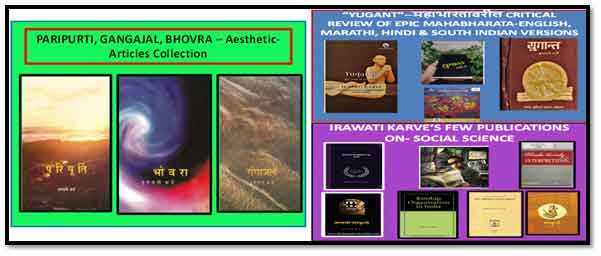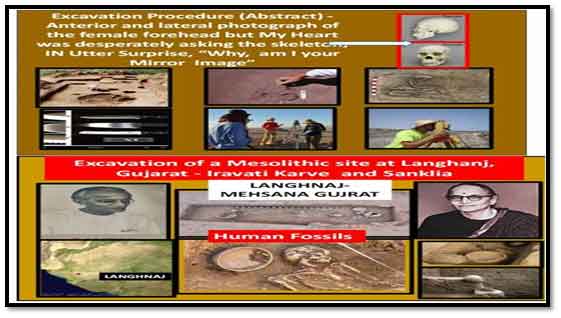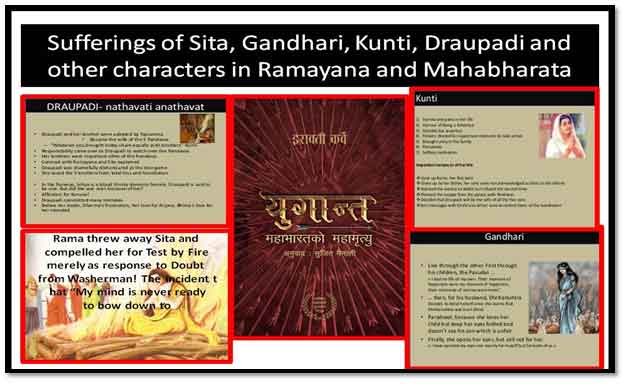
Dr. Iravati Karve [15 December 1905 —-11 August 1970 ] is India’s first pioneer, leading anthropological researcher and world-renowned researcher in sociology. Anthropologist, social scientist, atheist, rationalist and literati, the great writer and orator known to Maharashtra in various capacities. A progressive thinker who has become an example of women’s freedom is Dr. Iravati Karve. A very highly educated, cultured personality, world famous, loving to everyone, happy in the kitchen, cheerful, maintaining relationships while working and always ahead of time, the great Talented woman i.e. Iravati Karve.
Her father Ganesh Hari Karmarkar was working in Burma as an engineer in Burmatan Company. He named him Irawati after the Hirawadi River in Burma.She was placed in Hujurpaga Boarding School in Pune at the age of seven. During the school year, Hujurpage’s “Balikadarsa” issue published her poem “Kaifiyat” describing her beggar’s mood. Along with research, her enthusiasm for traveling was unparalleled. She is famous for being the first woman two-wheeler driver in Pune in 1952.
For most of her school and college life, she used to stay with the then principal of Fergusson College, Wrangler Paranjape. The atmosphere in Paranjpe’s house was cultured yet modern, high class and conducive to literary taste and poetic humor. Being with Wrangler Paranjape at a tender age had an impact on her later life
She had an attractive appearance with reddish fair complexion, height of five and a half feet, lean build, bright blue eyes, brilliance of intelligence, agility of gait and a kind of self-confidence. Along with an attractive and progressive personality, she had innate intellectual brilliance.’She was married to Dinkar Dhondo Karve, principal of Fergusson College, while she was a lover of Bharat Ratna Maharshi Dhondo Keshav Karve.

They had a daughter named Gauri and a son named Anand. Irawati had an extraordinary family heritage in the form of Maharshi Dhondo Keshav Karve, the great social reformer who was awarded the ‘Bharat Ratna’ by Pandit Jawaharlal Nehru and who enjoyed the company of Albert Einstein.
Iravati Bai is one of the most famous Talented woman in Maharashtra like Pandita Ramabai and Durga Bhagwat. Dr. Iravati Karve’s area of expertise was Psychology, Sociology. To study and survey the subject of ‘Anthropology’, he went to different regions of India and participated directly in the work. She was known as a renowned fine writer and thinker.
Professor Narhar Kurundkar has referred to it as “the forerunner of the fine essay” as a flexible, natural language. She had a deep study of Indian language, Mahabharata, Ramayana, Vedawangmay. The number of her research papers goes into 100. With the support of her husband, Iravati Karve studied abroad in Germany in Anthropology, Human Genetics and Eugenics.
There she studied race, human anatomy, and genetics. All studies were instrumental in shaping her thinking from her experiences in Germany. In the early 20th century there were ‘fieldwork oriented’ research methods and later they realized that research could be done through case studies.
She dominated the field of sociology in India as well as outside India. She worked on relationships by studying Indology, Indian history, culture, literature and philosophy. In anthropological investigations, he, cultural folk songs, epics, oral traditions; Surveyed them. Similarly, while also studying urbanization, women, language, race, studied and collected folk songs of other provinces of India.In her article “Some Folk Songs of Maharashtra” Iravati has presented the folk tradition before us. Sarojini Babar, Durga Bhagwat and Iravati Karve enriched Marathi’s path of knowledge by exploiting various fields of research. Never ignored India.
After doing her PhD in Germany’s Kaiser Wilhelm Institute of Anthropology, she came to Pune and studied at S. N. D. T. served as Chancellor and Chancellor of the University. Worked continuously for forty years till her retirement as Head of Department of Sociology and Anthropology at Deccan College Research Institute, Pune. She was the President of the Anthropology Section of the National Science Congress held in New Delhi in 1947. December 2005 to 2006 was the birth centenary year of Dr. Iravati Karve. At the same time, the centenary golden jubilee year of Mumbai University was also happening. During these golden years, the Marathi Department of Mumbai University organized a seminar in Karve’s memory.

Her Popular Books collection of fine articles like Bhowara, Gangajal, Paripurti and he has written “Yuganta” review book on Mahabharata. 1 Culture of Marathi People 2 Our Culture 3 Social Structure of Hindus 4 Religion 5 Maharashtra – A Study 6 Culture 7 Kinship Organization in India He has written books like ‘Kinship Organization in India’. Also many articles have been written.
An independent thinker, a researcher, a hardworking professor, a writer and a speaker, she developed her personality and spread that knowledge through different mediums. One noteworthy thing is that she has included in the book ‘Gangajal’, five poems which express her Psychic Turmoil also. It was published after her death in 1972.

First female anthropologist.
While at Deccan College, Iravati Karve and Sanklia excavated the medieval site of Langhanaj in Gujarat. Since human remains were also found at that place, this research became important. Can differences between ethnic and linguistic groups be studied on the basis of structural and genetic makeup? This was the core of her research. She used Multivariate Analysis to conduct cultural and biological studies in humans.” She received her Ph. D. degree from the University of Berlin with a thesis on “The Normal Asymmetry of the Human Skull.”
Biogenetic traits were an important component of Iravati Karve’s research as she and her students anthropologically surveyed the science related to the form and structure of animals and plants, such as skin, skin color, hair type, eye pigmentation, etc., considered to be under genetic control

By the end of 1948, Dr. Karve conducted an anthropological survey in Maharashtra. It presents a report on biology which gives information about body structure and functions. The report also includes an ethnographical note on Maratha society. From 1951 to 1954, she in collaboration with Dr. V. M. Dandekar, further carried out anthropological research and survey work on various castes and tribes of Gujarat, Maharashtra, Mysore and Orissa.
Iravati Karve writes in her article about “Excavation” that, “we, chief officers and other workers used to go to the excavation site. After deciding the area to be dug, we used to fix the place by hammering the pegs. Sometimes we used to dig big pits and sometimes small ones. The organ that comes out of that lump of soil was taken forward and cleaned with the help of Knife, Packing Niddle and Brush.
Painters and surveyors used to take photos and pictures of pits, remains and prepare maps. I had mainly studied human skulls and bones, so it was decided that human organs should be given to me when I saw them. After removing the organ from the lump, I cleaned thoroughly. After drying, the photos were taken away. After thousands and thousands of years, taking them out, they were exposed to the sun. As each skeleton was taken out, my heart was filled with a strange excitement and enthusiasm. A similar skeleton of a young girl was found. Sometimes I felt the pupils moving in the hollows of those eyes, while the bright teeth seemed to smile knowingly. But the heart was desperately asking the skeleton, IN Utter Surprise, “Why, are you My Mirror Image”
Dialogue between Urmila Deshpande (Irawati’s Granddaughter) – ‘Thiago Pinto Barbosa’- 2021
1
In the late 1920s, Iravati Karve moved to Berlin for her doctoral research at the now-infamous “Kaiser Wilhelm Institute for Anthropology”, Human Genetics and Eugenics (KWI-A), a turbulent period in Nazi-influenced Germany. Then after the First World War, the entire city was living in a state of decay. The institute was growing into a well-established center for unethical research on “ethnic cleansing” of the Aryan race. Iravati Karve saw the racist bias of her professors and denounced them.
Eugene Fisher tasked Irawati Karve to prove the correlation between race and cranial asymmetry, a physical characteristic that led to better development of the right side of the brain and was responsible for better development, intelligence, and civilization. This feature was expected by ‘Eugene Fisher’ to be linked to European races. Iravati Karve measured hundreds of skulls, many in German colonial territories, and proved that this ‘racist hypothesis’ was false.

No correlation was seen between race and measured skull size. Iravati Karve’s “General Asymmetry of the Human Skull” was the only piece that boldly directly refuted the ‘Nazi racist’ theory of the time. Such a clear conclusion was drawn by Thiago Pinto Barbosa. Barbosa also brings out in his conversation with Irawati’s Grand Daugher Urmila Deshpande the deficiencies and errors such as presence of occasional German Influence, Racial Elements in her framework in interpretations on ‘Caste and Tribes”. This aberration is brought out in the conversation.
What is ‘Anthropology’? [ANTHROPOLOGY]
Anthropology is the scientific study of human behavior and the physical, social and cultural growth of humans from the existence of humans till now. Anthropology is the study of all human groups from the primitive stages of man to the advanced ones of today. Anthropology is the only science that studies human beings as they are interrelated with all other sciences. And Irawati Karve perused the studies with intensity, fervor and passion.
Irawati Karve Museum of Anthropology
Under the Department of Anthropology, Savitribai Phule Pune University, there is a unique museum covering an area of three thousand square feet on the ground floor. Collected, a total of 1090 documents have been preserved. The museum was established in April 1978. Further, on 15 December 1993, the museum was named ‘Iravati Karve Anthropology Museum’ in her honor as the founder of the Department of Anthropology and the first woman anthropologist.

The museum has her photographs on both sides and two vibrant masks from the ‘Warli tribe’ on either side of a photographs of Irawati Karve, have been installed at the entrance. The museum is divided into three sections namely Footprints, Home and Earth and “Celebration Gallery”. All sections tell the story of human evolution. We get a visual representation of primitive man, modern man and evolutionary events. Plastic pots of contemporary fossils are also included. Tools like stone tablets, axes and weapons from the Neolithic age are displayed in glass cases.
“Home and Earth—–” This section contains information about tools and implements used in agriculture, fishing and hunting, fishing nets, traps used for catching birds and fowls, bows and arrows used by different tribes of India.
Celebration Gallery—- includes artifacts made by tribals during festivals ..beads, silver, copper and thread ornaments, musical instruments, colorful masks and terracotta depicting tribal rituals.
Social Scientist …….Irawati Karve
Sociology is the study of human relationships with society. Social factors and social events are included in it. The mind of the society, the general tendency of the mind, the customs followed by the society are explored in sociology.
Iravati Karve is a student of Professor GS Ghurye. She was an unparalleled researcher in the world. When anthropologists studied tribal and simple culture, the importance of kinship came to light. Kinship plays an important role in social, economic and religious life. In India, Iravati Karve did special research on kinship. She shares the importance of family, kinship, caste and religion as the basis of Indian society and the broad equation of Indian society with Hindu society, Kinship Organization in India, Hindu Society A Definition, Village Group Relations, Social Dynamics of Growing Cities and Surrounding Areas, Maharashtra Land And he has created sociological books like Folk, Yugant, Hindu culture, Hindu society – an interpretation. Several of her conceptual books are in English language.
YUGANT, BHOWRA & PARIPURTI- Critical Evaluation of Legends and Feminism.
She has written a review book on Mahabharata called Yugant. Yugant is the best as a fine work. The depiction of men and women in it is the glory of Yugant. Yugant’s writing is her famous and popular work, with an interesting and deep characterization of the characters. Gandhari, Kunti, Draupadi and other characters in Mahabharata have been well analyzed. The secondary position given to women as well as the Aspects and Nuances in the Mahabharata have been revealed.She showed her vehement and strong disapproval of widows being shaved, girls being forced to become Ecstatic. at an early age, ascetic initiation being imposed at an early age. She was very adamant about women’s rights. One of her famous and striking statements opposing the male rights patriarchal social structure was: “Why should women, while fighting men for rights, fight only for equal rights? Always fight for more rights”. ‘Yugant’ won the 1972 Sahitya Akademi Award, as well as the Maharashtra Government Award.
She writes “Just as a ‘Patch Work or Quilt’ is made up of pieces of different colors and shapes, society is made up of different people. They come together. They form relationships with each other. mix and break with each other .and yet the thread that connects them to society still remains integrated. “To study group relations in the village, she interviewed a total of 343 families spread over twenty-one castes during that period. Iravati Karve is called the “Pioneer of Indian Sociology”.
Irawati Karve and her Literary Contributions
For the purpose of research, she traveled all over India and the world, along with research books, he also wrote fine prose books like Paripoorti, Bhowra, Gangajal. Her name became ubiquitous in the Marathi literary world. Other people like Mamanji, Grandfather, etc. Paripurti–Written in 1949, Paripurti is a book of 150 pages and contains 18 articles on various topics like “Gift of Reincarnation”, “Twins”, “Mahar and Maharashtra”, Movement, Paripurti. It was not possible that death immortalized Sita as a pure character loving and commited Female and wife. Rama threw away Sita and compelled her for Test by Fire merely as response to Doubt from Washerman! The incident that “My mind is never ready to bow down to .

The book ‘Bhovara’ was written in 1964 and has 184 pages. It contains a total of twenty chapters, which includes, like Dwarka, Bharmanti, Malhar, Pravas Sampala, Darwin’s Theory, Satyacha Shodh (Search for Truth). This Book Bhovara (The Vortex or Turmoil) considered as excellent out feet in Marathi Literature, reads like storey Book. Chapter, Yatra, is the journey of the writer from Srinagar to Rudraprayag Badrinath, Kedarnath, Rishikesh is described in very appropriate words and sums up her bitter-sweet experiences which have come through her life described in heart-felt words. Reader feels like Re- experiencing them as they read.. Her studious attitude, outspokenness is easily felt. More importantly BHOVARA is collection of her Travel narratives but its soul is Scientific Critical Investigation. The Chapter –‘Search for Truth’ makes critical Enquiry into Egyptian, Babylon and Indian ‘Vaidik’ Legends and Anthropological Investigations in England, China and elsewhere. It also deals with development of Scientific Methodologies in assessing and identifying Age of the Excavated Bones, Human and Monkey Skeletons and also deals with illustrations, Fraudulent investigations done in England and elsewhere in deciding the Age of excavated Human and Animal skeletons.
On the other hand her Chapter-8, ‘Bhoke Rihili” (Holes Survived’) deals with travel narratives of African Countries, Jordan up to ‘Rift Valley’etc when Irawati Karve was on Tour for an important Anthropological Surveys Conference. Two Scientists made presentations on Traces of human habitation found on dry riverbanks from ancient times and the transformation of river waters into deserts and the creation of ‘Rift Valleys’ are beautifully described. While concluding the Heart-wrenching the travelogue she reminds us of need for ‘Tapi- Narmada’ valley studies.

Irawati karve’s Inspirations
She has written numerous memoirs of her father-in-law Maharshi Dhondo Keshav Karve. In it, his qualities as well as his nature, his likes and dislikes are described in very subtle words. The song “Antaricha Gyandiva Malvu Nako Re” (Do not allow Extinction Of the Light of Inspiration in your Heart) sung by him in the morning on the day of Padwa was always etched in the writer’s mind. Daughter-in-law!

Gangajal- Gangajal is a book published in 1972 after the death of Irawati and has 156 pages. It has 14 short stories like Mother Found, Ekaki, Kinkaali, Another Mamanji, Boyfriend, ‘Devla Vina Gaon”.
In another article Mamanji she writes about ‘Wrangler Paranjape’ and many pleasant memories of him. In one sense, her character, behavior, flow of life all seem to be indicative of a certain era, but on the other hand, her Extraordinary Intellect, (common sense), immense affection and childlike manners are a combination. Her observation about Wrangler Paranjpe that his life cannot be fitted into any linear framework has been painted in a very humorous way.
She is recognized as Literati who gave new shape to the fine prose to become Knight -Respected Master. His name became ubiquitous in the Marathi literary world. She was a poet who listens to the music of the rain and a scientist who examines human skeletons at the same time. Both things were permeated in her body, she lived her entire life with ears and eyes open. She ‘read people’ in books. She also loitered and absorbed in Stones and Boulders. She certainly had knowledge of the law and deep sense of Social commitment. My Salute to such a genius
Introduction to the Script
On the occasion of Death Anniversary on August 11, 2022, of Irawati Karve the Genius, First Anthropologist, sociologist and writer, a Programme was organized to commemorate her achievements and Pay tributes to her by presenting her ‘life Journey’ summarizing her historical contribution on 18 August 2022, Lokmanya Seva Sangh, Vile Parle, for these senior citizens. It was presented by the Senior Citizens Branch.
In the program presentation, Dr. Rashmi Fadnavis Sangh Working (Lo. Sec. Sangh), Meera Pendse, Amita Manerikar,Maya Kulkarni, Vasanti Gokhale, participated. Vasanti Gokhale has scripted for the Screen Play. It aims to Unravel her unfolding life span by depicting the important moments in her life.
VASANTI GOKHALE
(Translated by Anil Gokhale)














































